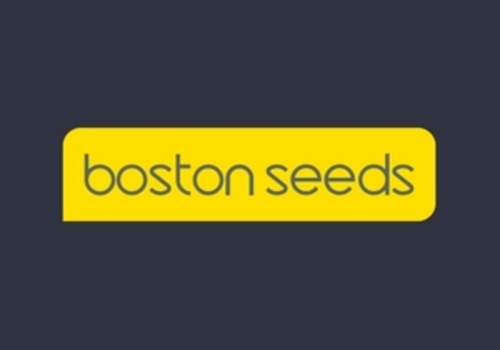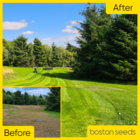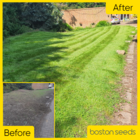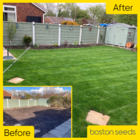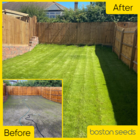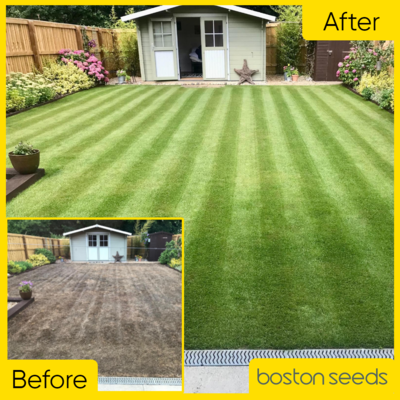BS Economy Grass Seed
Looking for cheap grass seed? BS Economy Grass Seed is specifically designed to produce a quality turf on a budget. When you need GREEN and you need FAST, our Economy Grass Seed is second to none. This terrific value for money grass seed mixture germinates and grows rapidly, giving green cover in record time. Perfect for when you need quick establishment and for budget lawn and landscape projects.
- Fast germinating, fast growing and provides rapid green cover
- Creates a strong, durable lawn, very competitive against weeds
- Economical solution for large landscape projects
- Contains: 95% Perennial Ryegrass and 5% Strong Creeping Red Rescue
- Sow at 25-50 grams per sq/m - 20kg covers 400-800sq/m
- For best results, use with Pre-Seeding Fertiliser and a spreader
Unsure how much seed you need? Our handy Grass Seed Calculator will help you work it out!
Mixture Specification
BS Economy Grass Seed Mixture Specifications
BS Economy Grass Seed delivers unrivalled speed of germination at exceptional value for money.
Perennial Ryegrass
- Variety selected for rapid germination in as little as 7 days.
- Rapid growth and highly persistent to deliver green cover in record time.
- Strong, durable and resilient for all lawn and landscaping projects.
Strong Creeping Red Fescue
- Versatile creeping fescue species to complement the rapid-growing Perennial Ryegrass.
- Horizontal, creeping growth suppresses weeds and ensures a thick, tough and resilient sward.
How we can help!
At Boston Seeds we take pride in excellent customer service. If you're growing a lawn from scratch but unsure how much grass seed you need, our handy Grass Seed Calculator can help you figure it out in just a few clicks!
With Next Day Delivery on hundreds of items too, choosing from our extensive range of lawn seed couldn't be easier.
Have a question about best practice when it comes to growing your lawn from grass seed? Or unsure which grass seed is best for your needs? Get in touch with our friendly experts who'll be happy to help.
Why Choose Boston Seeds?
With over two decades of experience, Boston Seeds is a family-run business whose passion lies in creating beautiful outdoor spaces with high-quality grass and wildflower seed mixtures.
When buying from Boston Seeds, you are buying:
- Quality assurance: Every one of our lawn seed and grass seed mixes has been expertly curated and rigorously tested to ensure they create beautiful, lush and healthy lawns.
- Customer satisfaction: We take pride in providing the best possible service and product for our customers. If you've got any questions or concerns our team is always happy to help.
- Expert advice: We are always on hand to help provide expert advice on planting and sowing your grass seed and expert lawn care tips to ensure you get the best lawn. Take a look at our advice section or get in touch.
- Versatility: Whatever your needs and requirements are, we've got the grass seed mixture for you. Whether you're looking for shade tolerant, fast-growing or hard wearing grass seed we've got it all.
Sowing & Establishment
How to Sow a New Lawn with Economy Lawn Grass Seed
1 - Clear the area
Clear the area and remove any stones, weeds and other debris.
2 - Improve the soil
Cultivate the area to a depth of 15cm and remove any debris that is unearthed. For heavy clay soils, optionally, mix in sharp sand.
3 - Create a level seed bed
Level and rake over the area. Use a lawn roller to firm the soil, if required.
4 - Allow the soil to settle
If possible, leave the soil for a week to allow a flush of weeds to come through; remove before sowing.
5 - Final ground preparation
Rake the area to loosen the top layer of soil. Apply our Pre-Seeding Lawn Fertiliser and rake into the soil.
6 - Sowing the grass seed
Spread the grass seed evenly across the area at 50g/sqm. A spreader can be used for accurate application.
7 - Rake and roll
This step is essential for successful establishment. Gently rake over the area again to incorporate the seed into the top 1-2cm of the soil, so that there is very little seed still visible on the surface. Then lightly roll or tread the seeds in to ensure good seed-to-soil contact. A harrow can be used for large areas.
8 - Water
If going through a period of drought, water the area every other evening for the first few weeks. If regular rainfall, manually watering will not be necessary.
9 - Mowing the lawn
Under optimum conditions, the seed should germinate within approximately 7-10 days. Once it reaches 3-4 inches, cut the lawn for the first time, gradually lowering the height with each subsequent cut as desired.
How to Repair an Existing Lawn with Economy Lawn Grass Seed
1 - Prepare the grass
Cut the existing grass short and almost scalp the lawn with the lawn mower. Remove any dead grass, debris and thatch.
2 - Improve the soil
Scarify or rake the surface to loosen the top layer.
3 - Aerate the lawn
Optionally, to aid drainage, use a garden fork or aerator to create small holes of around 1-2 inches deep.
4 - Sow the grass seed
Spread the grass seed evenly across the area at a minimum of 25g/sqm. A spreader can be used for accurate application.
5 - Rake and roll
This step is essential for successful establishment. Gently rake over the area again to incorporate the seed into the top 1-2cm of the soil, so that there is very little seed still visible on the surface. Then lightly roll or tread the seeds in to ensure good seed-to-soil contact. A harrow can be used for large areas.
6 - Water
If going through a period of drought, water the area every other evening for the first couple of weeks. If regular rainfall, manual watering won’t be needed.
7 - Mowing the lawn
Under optimum conditions, the seed should germinate within approximately 7-10 days. Once it reaches a height of 3-4 inches, cut the lawn for the first time, gradually lowering the height with each subsequent cut as desired.
Maintenance
1 - Germination
The best time to sow our Economy Lawn Seed is from March-October, when the soil temperature is around 8-10 degrees. Under optimum conditions, the seed should germinate within 7-10 days from sowing.
2 - Watering
Grass seed requires warmth, moisture and light to germinate. Typically, autumn will provide more favourable conditions for sowing in terms of moisture, however, if there is a period of drought, manually watering the seeds will be beneficial – this can be done every other evening to allow the moisture to soak into the soil.
3 - Mowing
Allow your lawn to grow to around 3-4 inches in height before cutting your lawn. This can be reduced by half an inch each time until you reach the desired height. An established lawn sown with our Economy Lawn Grass Seed can be cut as low as 20-40mm. It is important to remove the grass cuttings as dead grass will prevent sunlight from getting to the new grass.
4 - Fertilisation
Regularly fertilising your lawn will provide it with the nutrients it requires to stay lush and green all year-round.
Once the lawn is four months old, you can apply our quick release fertilisers. Dependent on the time of year, choose our Spring and Summer Fertiliser or Autumn and Winter Fertiliser. Around four applications a year, with a minimum of three months between applications will provide sufficient nutrients for an established lawn.
5 - Scarifying, Aerating and Overseeding
Both autumn and spring are good times of year to aerate and scarify your lawn, and tackle any worn areas by overseeding. Aerating your lawn is optional, but particularly useful if you have heavier clay soils where waterlogging may be a problem. Use an aerator or a garden fork to aid drainage. Scarifying is also beneficial in removing any dead grass, moss and thatch that may be hindering the growth of your existing grass.
After this process, there may be some bare patches amongst your lawn – this is the perfect time to overseed when the soil temperature is optimum and moisture is plentiful. We recommend overseeding with the same grass seed mixture as you have previously sown for a uniform appearance.
6 - Controlling Weeds
Unfortunately, as comes with seedbed preparation, weed seeds can lay dormant in the soil and it’s not until they are disturbed and the conditions are ideal, that they then can start to germinate.
If you find that weeds appear during establishment, these will generally be taken out by regular mowing once the lawn has reached around 3-4 inches in height. If the weeds are recurring, after 4 months, a Selective Weedkiller can be applied which will kill common lawn weeds, whilst leaving the existing grass unharmed.
7 – Controlling Moss
Moss can become problematic in areas that are particularly damp and shady. Moss Killer is best applied during March-October when moss is actively growing.
On a newly established area (under 5 months old), avoid using a moss killer as this will be too strong for the lawn. Instead, rake over the area to loosen and remove the moss and add further seed if required.
Once the lawn is established (over 5 months old), a moss killer can be applied such as our Lawn, Feed and Weed plus Moss Killer for light areas of moss, or our Lawn Revivor and Moss Destroyer for more heavily infested areas. After using these, the moss will turn black within a couple of weeks, rake and remove this and overseed with one of our lawn seeds.
FAQs
Will Economy Grass Seed Still Create a Good Lawn?
Economy grass seed is not only great value for money, but it will also create a beautiful, lush green lawn for a cheaper cost. Economy lawn seed is great for bigger landscaping projects, or when you need your lawn to germinate and grow very quickly.
Should I Choose Premium or Economy Grass Seed?
It will depend on what you're using the grass seed for, where it's being used, and your budget. Premium grass seed is best for ornamental use or those looking for a top quality lawn, whereas economy grass seed is great for people looking for a quick-growing and hard-wearing, at great value - it's great for those with kids, pets or for bigger areas.
For more information on what lawn seed is best for you, read our blog on what grass seed you need.
What is Economy Grass Seed Used For?
Economy grass seed is great for general use, large landscaping projects and any other areas that require rapid germination, quick growth and strong wear-tolerance.
Buy With Confidence
